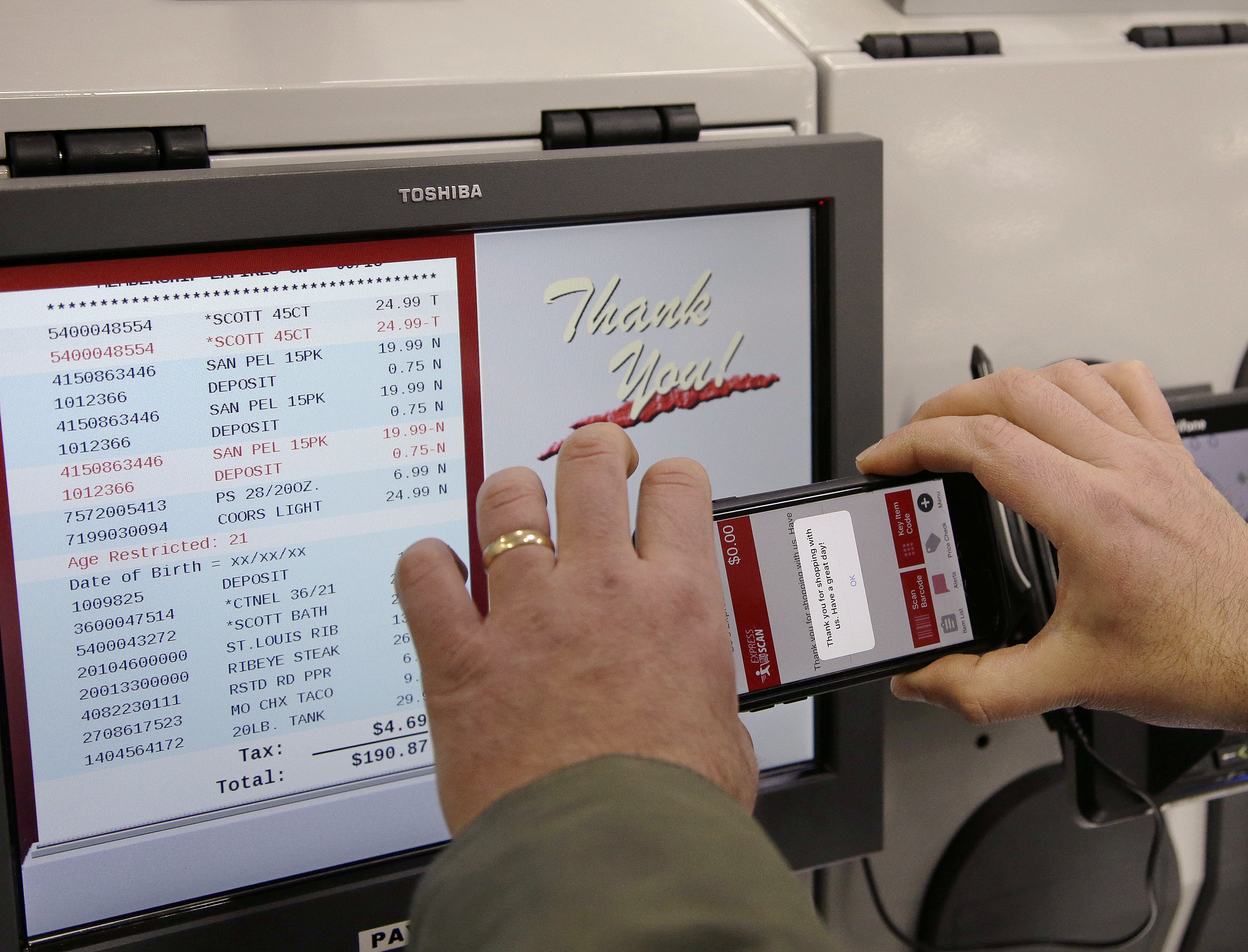
By ANNE D’INNOCENZIO
AP Retail Writer
NEW YORK (AP) — Shoppers at self-checkout lanes scanning all their groceries after they’re done shopping? Old school. More stores are letting customer tally their choices with a phone app or store device as they roam the aisles. For customers, scanning as they go can be faster and make it simpler to keep track of spending. For stores, the big expansion of this technology coming this year costs less than installing more self-checkouts.
Like many changes in retail, the expansion of scan-and-go comes from retailers trying to make store shopping more convenient and hang on to customers used to Amazon, which just opened a cashier-less store in Seattle. And like other automation technologies, it shifts more of the work to shoppers while freeing up employees for higher-value tasks. That’s especially critical as stores look for ways to make their workers more efficient as they wrestle with rising wages.
The convenience of scanning while she shops is what Kari Malinak likes. She just started using the technology at a Walmart in Fort Worth, Texas.
“I’m a persnickety shopper,” Malinak said. “I can’t stand it when they bag my produce. It gets all bruised. I like to have control. And I like the quick and easy aspect.” She says she also likes the idea of having a running total of spending as she shops.The technology, while slightly different from chain to chain, allows shoppers at stores like Kroger and B.J.’s Wholesale Club to scan UPC codes on items as they shop. It can be used for lots of products beyond just groceries, and people change their minds about something, they can delete items and change quantities before they check out.
Some stores allow payment directly from the phone, with a greeter then checking over the digital receipt, while others require shoppers to go to a self-checkout lane or a kiosk to finalize their purchases.
A big push is coming this year from big chains: Kroger Co., the nation’s largest traditional grocery chain, is adding the scan-and-go technology to 400 stores. Walmart is testing the service in 120 stores, while all its Sam’s Club stores, which number around 600, have it. B.J.’s Wholesale Club has launched the service in a handful of stores and plans to add it to about 100 clubs this year.
One reason is that stores are investing less in their self-checkout lanes and opting for scan-and-go technology that’s less expensive because it doesn’t need as much special hardware — just an app or the scanners, says Jason Goldberg, senior vice president of commerce and content practice at consulting group SapientRazorfish.
But while some customers feel comfortable scanning while shopping, plenty of others don’t.
“It’s a huge barrier for most retailers to get a consumer to download their app,” says Goldberg. He said stores also need to work on letting shoppers pay with their phones, so customers don’t have to go to a kiosk to finalize their purchases.
Most executives wouldn’t say what percent of their transactions come from the service. But Dusty Lutz of retail technology company NCR Corp., which works with major grocery clients, says scan-and-go mobile shopping accounts for 5 to 15 percent of customer transactions, based on an analysis of 40 retailers.
Walmart — which tested scan-and-go in a few stores in 2013 but ended the trial because shoppers found the technology too clunky — says the improved service is now the most preferred checkout
method among those who tested it. Sam’s Club says 80 percent of its members who use it use it again within 90 days and its scan & go transactions have doubled this year.
Some stores are enticing shoppers to spend more by pinging them with coupons while they shop with the phone. Executives from B.J.’s and NCR say shoppers are actually throwing more in their cart with this new technology.
Still, not everything can be scanned. At BJ’s clubs, jewelry and gift cards can’t be scanned but can be purchased at a pay station. Stores also have to be careful about theft. At Walmart, there’s an honor code when shoppers scan the barcode on the produce and enter in the weight. But the company says some purchases are randomly checked on their way through the express lane.
And the technology the big chains are using isn’t as effortless as the sensors and automatic payment at Amazon’s cashier-less stores. There, shoppers enter by scanning their phones. The store technology itself keeps track of what they pick up and charges them after they leave. It uses computer vision, machine learning algorithms and sensors to analyze what people are grabbing.
Amazon’s store isn’t without employees — there are workers making food, stocking shelves and helping customers. And grocery executives say the scan-and-go services won’t eliminate jobs — rather, some cashiers will move to other parts of the store, like new online pickup stations.
“I don’t see the death of the cashier,” said NCR’s Lutz. “They will be doing things that provide more service to the shopper.”
Stores declined to say whether their ultimate goal was to replicate Amazon’s Go technology, saying the plan is to keep investing in the latest technology and improve customers’ experience.
“We’re trying to make our trips more convenient,” said Chris Baldwin, CEO of BJ’s.
And for shoppers who find it most convenient to go the traditional route with a cashier scanning their purchases? “Our goal is to provide members with a variety of options so they can check out however they prefer,” said Carrie McKnight, a Sam’s Club spokeswoman.



















